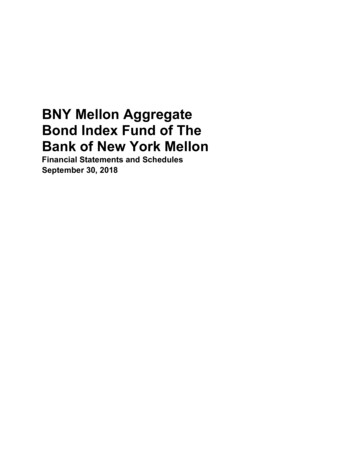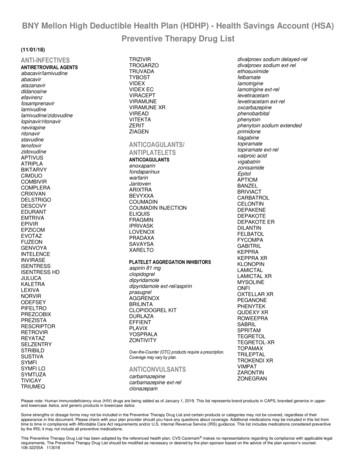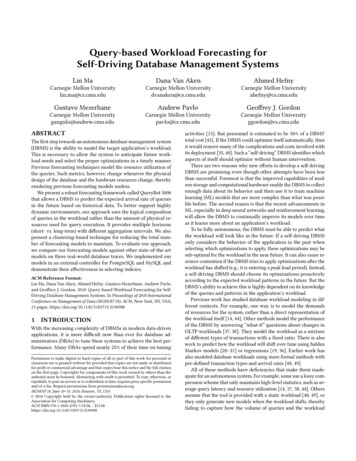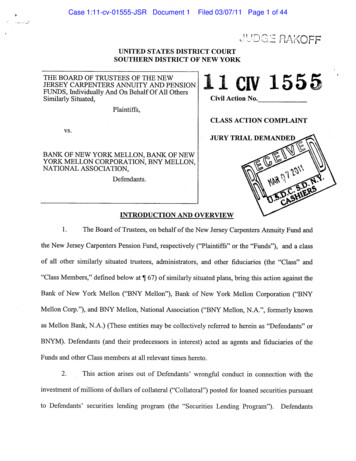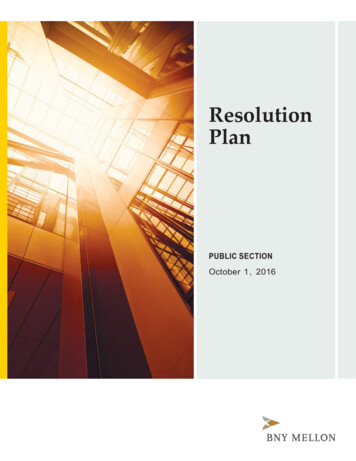
Transcription
ResolutionPlanPUBLIC SECTIONOctober 1 , 2016
Table of ContentsKey Terms. 11.Introduction . 61.1 BNY Mellon’s Role as a Global Financial Intermediary . 111.2 The April 2016 Letter and Our Transition to the SPOE Strategy . 121.3 Benefits of the SPOE Strategy . 132.BNY Mellon’s SPOE Strategy . 153.Remediation of Deficiencies in the 2015 Plan. 203.1 Operational – Bridge Bank Strategy . 203.2 Approach to Deficiencies not Remediated by Transition to the SPOE Strategy. 203.3 Operational – Shared Services . 213.3.1 Identification and Mapping of Critical Services . 213.3.2 Analysis of Potential Risks to Operational Continuity and Separability . 233.3.3 Incorporation of Critical Services Mapping Into Legal Entity RationalizationCriteria and Implementation Efforts . 243.4 Legal Entity Rationalization . 253.4.1 Status of 2015 Plan Legal Entity Rationalization Projects . 253.4.2 Establishment of the Entity Governance Committee . 263.4.3 Application of Legal Entity Rationalization Criteria . 284.Plans to Address Shortcomings . 294.1 Shortcomings Addressed by Transition to the SPOE Strategy. 294.2 Liquidity – Intraday Credit . 305.Further Enhancing BNY Mellon’s Resolvability by 2017 . 315.1 2017 Resolvability Program . 315.2 Key Projects to Enhance Resolvability . 325.3 Improving our Resiliency and Reducing Risk to the Broader Market . 376.Conclusion . 39Appendix: BNY Mellon’s Material Entities and Core Business Lines . 40
Key TermsThis Public Section uses “BNY Mellon” and the “firm” to refer to The Bank of New York MellonCorporation and its consolidated subsidiaries, i.e. the organization as a whole. Use of the firstperson plural (“we,” “us” or “our”) also refers to BNY Mellon. The term “Parent” refers solely toThe Bank of New York Mellon Corporation, the top-tier entity in our corporate hierarchy.Our 2016 Submission uses defined terms for parts of BNY Mellon and for terms with specificlegal, regulatory or technical definitions. For ease of reference, we define these terms in theGlossary and, as applicable, capitalize them where they are used in the text below.We annually reassess our designations of material entities and core business lines, which in the2016 Submission are the same as in our 2015 Plan. The following organizational chart showsour material entities. We have four core business lines: Asset Management, Asset Servicing,Clearing Services and Corporate Trust. Please refer to the Appendix of this Public Section formore information about each of our material entities and core business lines.BNY Mellon’s Material EntitiesThe Bank of New YorkMellon Corporation(Parent)DreyfusInstitutional BankThe DreyfusCorporation(The DreyfusCorporation)Pershing LLC(Pershing)MBSCSecuritiesCorporation(MBSC)The Bank ofNew YorkMellonTrustCompany, NA(BNY MellonTrust)The Bank ofNew York Mellon(Bank)BNY MellonInternationalOperations(India) PrivateLimited(BNY MellonInternationalOperationsIndia)BNY MellonInvestmentServicing(US) Inc.(BNYMellonInvestmentServicing)BranchMaterial entity (all material entities shown)Indirect subsidiary1The Bankof ies IndiaPrivateLimited(iNautix)Brussels Branch(Brussels Branch)London Branch(London Branch)BNYInvestmentManagementServices icesGroup, Inc.(TSG)TennesseeProcessingCenter LLC(TPC)
GlossaryTerm2015 Annual Report2015 Plan2016 Submission2017 Guidance2017 Plan2017 Resolvability ProgramAgenciesAgent BanksApril 2016 LetterBankBankruptcy CodeBNY Mellon SA/NVBNY Mellon TrustBridge Bank StrategyCCARConnectionCore business linesCrisis ContinuumCrisis Continuum FrameworkCrisis Management CoordinatorDefinitionParent’s Annual Report on Form 10-K for the year ended December 31,2015BNY Mellon’s July 1, 2015 resolution plan submission under the Title I RuleBNY Mellon’s required resolution plan submission due by October 1, 2016,containing this Public Section and the confidential information required bythe Agencies in the April 2016 LetterThe Agencies’ jointly issued Guidance for 2017 §165(d) Annual ResolutionPlan Submissions By Domestic Covered Companies that SubmittedResolution Plans in July 2015BNY Mellon’s required annual resolution plan submission under the Title IRule due by July 1, 2017BNY Mellon’s program of projects and related initiatives to further enhancethe firm’s resolvability by July 1, 2017 discussed in Section 5The Federal Reserve and the FDICCorrespondent banks and sub-custodiansAgencies’ April 12, 2016 feedback letter to BNY Mellon in response to the2015 Plan1The Bank of New York Mellon, a material entityTitle 11 of the United States CodeThe Bank of New York Mellon SA/NV, a material entityThe Bank of New York Mellon Trust Company, N.A., a material entityThe preferred resolution strategy contained in BNY Mellon’s 2015 PlanComprehensive Capital Analysis and ReviewA data-driven tool we built to store, maintain and regularly updateinformation on operational interconnections across the firm in a structured,searchable and analyzable mannerBNY Mellon’s business lines, including associated operations, services,functions and support, that would result in a material loss of revenue, profit,or franchise value upon failure. Additional information about BNY Mellon’score business lines can be found in the Appendix to this Public Section.A series of defined levels of stress from business-as-usual throughincreasing levels of severity up to and including resolution. Primarymonitoring tools for the Crisis Continuum levels include capital, liquidity andoperational key risk indicator thresholds.BNY Mellon’s governance framework for identifying and managing definedcrisis levels that may occur along the Crisis Continuum. Key componentsinclude crisis governance, measures and thresholds for monitoring andreporting crisis situations, internal and external escalation andcommunication plans, and potential responses at each crisis level.BNY Mellon’s global head of business continuity, who is responsible for,among other duties, coordinating actions to support execution of the SPOEStrategy based on the Master Playbook1On April 13, 2016, the Agencies jointly announced determinations and provided firm-specific feedbackon the 2015 resolution plans of BNY Mellon and seven other U.S. G-SIBs. The Agencies’ joint pressrelease, Agencies Announce Determinations and Provide Feedback on Resolution Plans of EightSystemically Important, Domestic Banking Institutions, is available bcreg/20160413a.htm.2
TermCritical operationsCritical ServicesDodd-Frank ActEnterprise Resolvability FrameworkEntity Governance CommitteeEntity Governance PolicyExecutive CommitteeFailure CatalystFDICFederal ReserveFinancial Market UtilityFSB GuidanceG-SIBIPOMaster PlaybookMaterial entityNew HoldCoObjects of SaleORRPOTCRemainCoDefinitionThose operations of BNY Mellon, including associated services, functionsand support, the failure or discontinuance of which, in the view of BNYMellon or as jointly directed by the Agencies, would pose a threat to thefinancial stability of the United StatesShared services that support our critical operationsDodd-Frank Wall Street Reform and Consumer Protection ActBNY Mellon’s previous governance framework, launched in 2015, for anumber of projects to enhance our operational capabilities andresolvability. Ongoing projects have since been transitioned into the 2017Resolvability Program.Senior-level committee at BNY Mellon responsible for overseeing the firm’slegal entity structure and providing strategic direction to enhance ouroverall resolvability in accordance with our legal entity rationalizationcriteriaBNY Mellon’s enterprise-wide policy that defines the scope of activitiessubject to oversight by the Entity Governance Committee, as discussed inSection 3.4.2BNY Mellon’s most senior management committeeHypothetical idiosyncratic event that leads to significant uncertainty aboutBNY Mellon’s ability to continue as a going concern and results in the firmentering the Runway Period under the SPOE StrategyFederal Deposit Insurance CorporationBoard of Governors of the Federal Reserve SystemMultilateral systems that, among other types of financial transactions,provide for the payment, clearing, and settlement of cash and securitiesamong financial institutions or between financial institutions and the systemFinancial Stability Board Recovery and Resolution Planning forSystemically Important Financial Institutions: Guidance on Identification ofCritical Functions and Critical Shared Services from July 16, 2013Global Systemically Important Bank, a designation applicable to BNYMellon that is published annually by the Financial Stability BoardInitial public offeringPlaybook that provides a clear, overarching framework for the sequencing,linkage and key information across BNY Mellon’s other playbooks, tosupport the Crisis Management Coordinator and coordinate timelyexecution of relevant actions necessary to implement the SPOE StrategyA BNY Mellon subsidiary or foreign office that is significant to the activitiesof a critical operation or core business line. Additional information on BNYMellon’s material entities can be found in the Appendix to this PublicSection.Holding company that would be created under the SPOE Strategy, to whichParent, following its bankruptcy filing, would transfer all of its subsidiariesand under which each subsidiary would continue as a going concernDiscrete BNY Mellon businesses that would be sold, wound-down ortransferred from New HoldCo pursuant to identified preferred andalternative strategies for their dispositionBNY Mellon’s Office of Recovery and Resolution PlanningOver-the-counterUnder the SPOE Strategy, the remaining BNY Mellon businesses andassociated entities that would be disposed of through an IPO after all otherObjects of Sale have been divested, wound down or transferred3
TermResolution PeriodResolution WeekendResolvability Analysis QuestionnaireRunway PeriodSECSPOE StrategyStabilization PeriodSupport AgreementPlaybookTitle I RuleTLACTrustDefinitionPeriod between the Parent’s filing for bankruptcy and the completion of theSPOE Strategy, including Resolution Weekend, the Stabilization Period,the Post-Stabilization Period and the exit from resolution of RemainCoUnder the SPOE Strategy, the two to three day-long period following theRunway Period and preceding the Stabilization Period; referred to as aweekend for ease of reference, but there is no constraint that prevents itfrom occurring mid-weekBNY Mellon questionnaire developed by the Entity Governance Committeeto facilitate consistent and thorough application of the legal entityrationalization criteria, discussed in further detail in Section 3.4.2Under the SPOE Strategy, period beginning at the Failure Catalyst andextending to Resolution Weekend, during which the firm recognizes it mightfail in a short period and begins to take actions in preparation for failureSecurities and Exchange CommissionBNY Mellon’s Single Point Of Entry resolution strategyUnder the SPOE Strategy, period that begins after Resolution Weekendand ends when market confidence in the stability and continuity of the BNYMellon businesses transferred to New HoldCo has been restoredContractual agreement designed to assure that subsidiary material entitiesremain liquid and solvent under the SPOE Strategy; referred to as a“contractually binding mechanism” in the 2017 GuidanceBNY Mellon’s detailed guides that focus on legal, financial and operationalissues and provide specific information to coordinate the timely executionof any actions necessary to implement the SPOE StrategyThe rule jointly adopted by the Agencies pursuant to Section 165(d) ofTitle I of the Dodd-Frank Act requiring certain large bank holdingcompanies to submit resolution plans annuallyTotal Loss-Absorbing Capacity, which includes capital and certain types ofunsecured debt instruments, as defined in regulations proposed by theFederal ReserveUnder the SPOE Strategy, the trust that would hold 100% of the equity ofNew HoldCo and would operate New HoldCo and subsidiaries for thebenefit of the stakeholders in the Parent’s Chapter 11 bankruptcy case;distinct from BNY Mellon Trust, a material entity4
***BNY Mellon’s resolution plan is based on a series of hypothetical scenarios and assumptions about futureevents and circumstances. Accordingly, many of the statements and assessments in this Public Sectionconstitute “forward-looking statements” within the meaning of the safe harbor provisions of the PrivateSecurities Litigation Reform Act of 1995. Words such as “estimate,” “forecast,” “project,” “anticipate,” “target,”“expect,” “intend,” “commit,” “believe,” “plan,” “goal,” “could,” “should,” “may,” “will,” “ensure,” “assure,”“strategy,” “opportunities,” “trends” and words of similar meaning signify forward-looking statements, as dostatements that relate to our future plans, objectives and strategies and to the objectives and effectiveness ofour risk management, capital and liquidity policies. These statements are based on the current beliefs andexpectations of BNY Mellon’s management and are subject to significant risks and uncertainties that aresubject to change based on various important factors (some of which are beyond BNY Mellon’s control). Actualoutcomes may differ materially from those set forth in the forward-looking statements as a result of numerousfactors, including those described under “Forward-Looking Statements” and “Risk Factors” in the Parent’s 2015Annual Report and Form 10-Q for the period ended June 30, 2016, and in other filings with the SEC, which wemake available on the Investor Relations section of our corporate website at https://www.bnymellon.com.BNY Mellon’s resolution plan is not binding on a bankruptcy court, our regulators or any other resolutionauthority, and in the event of the resolution of BNY Mellon, the strategies implemented by BNY Mellon, ourregulators or any other resolution authority could differ, possibly materially, from the strategies we havedescribed. In addition, our expectations and projections regarding the implementation of our resolutionstrategies are based on scenarios that are hypothetical, involve economic outcomes that are more adversethan expected and may not reflect events to which BNY Mellon is or may become subject. Our resolution planis also based on many significant assumptions, including with respect to the effects of the Failure Catalyst, theactions of clients, Financial Market Utilities, Agent Banks and regulators, Parent’s financial resources and itsability to provide financial resources to its material entities prior to its filing for bankruptcy proceedings, theability to sell, wind down or transfer Objects of Sale, and the ability to effect a disposition of RemainCo. None ofthese assumptions may prove to be correct in an actual resolution scenario. As a result, our resolutionstrategies in an actual resolution scenario, or the outcomes of our resolution strategies, could differ, possiblymaterially, from those we have described.The statements describing the Support Agreement and our intention to enter into the Support Agreement areforward-looking statements, based on our current expectations regarding the anticipated terms of the SupportAgreement and our ability to develop the Support Agreement prior to July 1, 2017. The terms of the SupportAgreement have not been finalized and may change, possibly materially, from our current expectations. Wehave also included information about projects we have undertaken, or are considering, in connection withresolution planning. Many of these projects are in process or under development. The statements with respectto these projects and their impact and effectiveness are forward-looking statements, based on our currentexpectations regarding our ability to complete and effect those projects and any actions that third parties musttake, or refrain from taking, to permit us to complete those projects. As a result, the timing of those projectsmay change, possibly materially, from what is currently expected. All forward-looking statements speak only asof the date on which such statements are made and BNY Mellon does not undertake to update the forwardlooking statements to reflect the impact of circumstances or events that may arise after the date of the forwardlooking statements.The information contained in the 2016 Submission, including the designation of “material entities” and “corebusiness lines,” has been prepared in accordance with applicable regulatory requirements and guidance.Differences in the presentation of information concerning our businesses and operations contained in thisPublic Section, relative to how BNY Mellon presents such information for other purposes, are solely due to ourefforts to comply with the rules governing the submission of resolution plans and do not reflect changes to ourorganizational structure, business practices or strategy.Financial information presented herein is as of December 31, 2015, unless noted otherwise.***5
1.IntroductionBNY Mellon’s 2016 Submission responds to the deficiencies and shortcomings identified by theAgencies in the April 2016 Letter and describes the actions we are taking to further enhance ourresolvability. As previously announced, following the receipt of feedback from the Agencies onour 2015 Plan, we have changed our preferred resolution strategy to the SPOE Strategy.2 Thischange remediates one of the three deficiencies and four of the five shortcomings in our 2015Plan that the Agencies jointly identified in the April 2016 Letter. The 2016 Submission describesthe actions we have taken to remediate both of the remaining deficiencies, one concerningshared services and another concerning legal entity rationalization. The 2016 Submission alsopresents our SPOE Strategy and describes the substantial efforts we are undertaking to achieveoperational readiness for its successful execution by July 2017, which include our plans toaddress the remaining shortcoming concerning intraday credit.Our board of directors and senior management have made enhancing BNY Mellon’sresolvability and resiliency one of our top strategic priorities. We have dedicated and willcontinue dedicating significant resources at every level of our organization to ensure that BNYMellon can be resolved without posing systemic risk to the financial system. We recognize theimportance of an orderly resolution of our firm given its unique role in the financial markets. OurSPOE Strategy is designed to ensure that, in the event of material financial distress or failure,BNY Mellon’s resolution would: Preserve essential market functions, such as U.S. Government Securities Clearing;Maintain the continuity of operations deemed critical to support our clients and thebroader market; andAvoid the need for extraordinary support from the government.The development of our SPOE Strategy involved subject matter experts from across ourorganization and included a thorough analysis of our structure, operations and businesses. Theresulting SPOE Strategy is operationally feasible and adaptable to a range of market conditions.We recognize that resolution planning is more than a compliance exercise. Our seniormanagement has directed changes to the business-as-usual functions of BNY Mellon toincorporate enhancements to our resolvability on an ongoing basis. We have embeddedresolvability considerations into governance frameworks and processes so that businessdecisions are made with resolvability concerns in mind and any proposed structural changesthat could impede an orderly resolution are appropriately mitigated. We are confident that manyof our investments to achieve operational readiness for an orderly resolution under theBankruptcy Code will make us a more resilient firm, supporting global financial systemicstability. Our preparations to minimize the potential impact in a resolution scenario on ourclients, and on the movement of cash and securities throughout global financial markets that wefacilitate, will further enhance BNY Mellon’s status as a trusted counterparty.2The Bank of New York Mellon Corporation, Form 8-K (July 21, 2016).6
Our Transition to a Single Point of Entry Resolution StrategyWe decided to adopt the SPOE Strategy after thorough analysis of the viability and executabilityof various options for resolving the firm and careful consideration of the guidance provided bythe Agencies.The preferred resolution strategy in our 2015 Plan was the Bridge Bank Strategy. A bridge bankis a bank with a temporary charter that the FDIC can create to facilitate the resolution of a failedbank under the Federal Deposit Insurance Act. As described in the public section of our 2015Plan, we considered certain features of the Bridge Bank Strategy appropriate for BNY Mellon.The Bridge Bank Strategy was a conservative approach, using an established process thatcontemplates a scenario in which our largest and most important subsidiary, the Bank, fails andenters into receivership proceedings administered by the FDIC. Consistent with the messagesin the public section of our 2015 Plan, we continued to evaluate the single point of entryresolution strategy, and we will maintain flexibility in our resolution planning approach.In October 2015, the Federal Reserve issued a proposed rule that would require the largestG-SIBs operating in the United States to hold sufficient amounts of TLAC to facilitate theirorderly resolution.3 This TLAC must be held in certain forms, which include equity andunsecured long-term debt issued by a G-SIB’s top-tier holding company. TLAC-eligible longterm debt can absorb losses in resolution to recapitalize a G-SIB’s material entity subsidiariesand support the continuity of its critical operations. Regulatory reforms such as the FederalReserve’s proposed TLAC rule, together with industry initiatives such as the ISDA 2015Universal Resolution Stay Protocol,4 have made the execution of a single point of entryresolution strategy more viable. Today, almost all of the U.S. G-SIBs have developed singlepoint of entry resolution strategies.Our SPOE Strategy provides for the rapid and orderly resolution of BNY Mellon under theBankruptcy Code in the event of material financial distress or failure by maintaining thecontinuity of our core business lines and critical operations. In reaching the decision to changeour resolution strategy, we considered certain advantages of the SPOE Strategy that wouldminimize its impact on financial markets, including both client and financial market infrastructurerelationships. The single point of entry in our SPOE Strategy refers to the Parent, which is theonly entity within our corporate structure that would enter into insolvency proceedings. TheSPOE Strategy provides a mechanism for our material entities, including the Bank and othersubsidiaries, to remain solvent and to continue operating as going concerns during theresolution period. The recapitalization of our material entities also avoids the complexity thatcould arise from potentially competing resolution regimes by making an FDIC receivership and3The Federal Reserve’s press release, Federal Reserve Board proposes new rule to strengthen theability of largest domestic and foreign banks operating in the United States to be resolved withoutextraordinary government support or taxpayer assistance, (October 30, 2015), is available bcreg/20151030a.htm.4For more information, please refer to the website of the International Swaps and DerivativesAssociation, ISDA 2015 Universal Resolution Stay Protocol, at agement/protocol/22.7
the establishment of a bridge bank unnecessary. Section 2 below describes the SPOE Strategyin more detail.Importantly, we will have sufficient financial resources to execute the SPOE Strategysuccessfully. On our second quarter 2016 earnings call, we announced that we may issueincremental debt specifically to support the SPOE Strategy. For example, in August 2016, BNYMellon issued 2 billion in senior debt, which resulted in contributable resources available foruse in execution of our SPOE Strategy to support the recapitalization of, and provision ofliquidity to, our operating entities.Remediation of DeficienciesWe are confident that we have fully remediated all three of the deficiencies jointly identified bythe Agencies in the April 2016 Letter. Remediation of the two deficiencies that remained afterour change to the SPOE Strategy required us to take the following actions: Identify and map all Critical Services that support our core business lines and criticaloperations, analyze risks to the continuity of these Critical Services, and considerassociated mitigants; Meet the deadlines in the project plan submitted with our 2015 Plan to align legal entitieswith our legal entity rationalization criteria, and demonstrate the existence of agovernance process that will ensure that the legal entity rationalization criteria areapplied and adhered to on an ongoing basis; and Incorporate our Critical Services mapping into the application and implementation of ourlegal entity rationalization criteria.We are confident that we have satisfied these requirements by taking the following actions: We identified and mapped all Critical Services that support our core business lines andcritical operations operating across our material entities and captured this information inConnection, a data-driven tool that stores and maintains the mapping of dependenciesand interconnections in a structured, searchable and analyzable manner. We developed and applied a comprehensive risk identification framework to identifypossible instances of risk to the continuity of our core business lines and criticaloperations in resolution. We continue to advance and are on track to meet the expected completion datessubmitted in our 2015 Plan for projects to align our structure with our legal entityrationalization criteria. We formed a new governance structure, with our new Entity Governance Committee asits cornerstone, empowered with senior-level membership and a broad mandate toensure that our legal entity rationalization criteria are applied and adhered to on anongoing basis.8
We carefully considered the concerns raised by the Agencies and took additional steps, beyondthose required by the Agencies, to self-identify additional potential obstacles to orderlyresolution and develop mitigants for the potential obstacles. For example: We refined the granularity of our Critical Services mapping beyond the requirements ofthe April 2016 Letter by identifying our core business lines’ and critical operations’dependencies not only on shared services, but also on key assets and key third parties. In addition to assessing risks to operational continuity, we assessed risks associatedwith the sale, transfer or wind-down of certain businesses and activities identified asObjects of Sale. We assessed risks to operational continuity related to the separation ofthese Objects of Sale, as well as risks to the execution of potential dispositiontransactions. We updated our legal entity rationalization criteria to reflect our SPOE Strategy and keyconcepts from the 2017 Guidance. We applied our updated legal entity rationalizationcriteria to all of our material entities through a process that was designed, implementedand overseen by the Entity Governance Committee. Through the application of our risk identification framework and legal entityrationalization criteria, we identified certain specific potential impediments to theresolvability of BNY Mellon. We identified corresponding mitigants to all of thesepotential impediments and, through our newly formed resolution governance structure,launched a series of projects to implement the mitigants.Key Projects to Further Enhance BNY Mellon’s Resolvability and Operationalize theSPOE StrategyBetween now and July 2017, we are executing a large-scale program to achieve operationalreadiness to execute our SPOE Strategy. Our 2017
2017 Plan BNY Mellon's required annual resolution plan submission under the Title I Rule due by July 1, 2017 2017 Resolvability Program BNY Mellon's program of projects and related initiatives to further enhance the firm's resolvability by July 1, 2017 discussed in Section 5 Agencies The Federal Reserve and the FDIC

